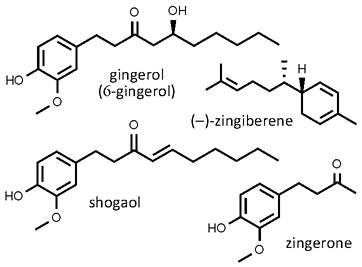 Zingiber officinale
Zingiber officinale
ginger
Back to “Spices: ginger (Zingiber officinale)rh”
Zingiber officinale Rosc. (Zingiberaceae); gemmer (Afrikaans); jiang (Chinese); gingembre (French); Ingwer (German); adrak (Hindi); zénzero (Italian); jinjaa, shouga (Japanese); saeng gang (Korean); haliya (Malay); gengibre, ingever (Portuguese); jengibre, anchoas (Spanish); khing (Thai)
DESCRIPTION The rhizomes (either green or mature) are fleshy, pale brown in colour and have a characteristic spicy odour and pungent taste.
THE PLANT A perennial herb (ca. 1 m or 3 ft 4 in. high) with large leaves arising from creeping and branching rhizomes. Yellow flowers are borne in cone-like clusters but plants rarely flower.
ORIGIN Ginger is a cultigen that has not yet been found in the wild.1,2 It probably originated from northeastern India or southern China and has been grown since ancient times as a spice and medicine (to counteract nausea and improve digestion).
CULTIVATION Humid and tropical or subtropical conditions are required. Pieces of rhizome (“bits”) are planted.2
HARVESTING Rhizomes are harvested after 5−7 months (for fresh ginger) or 8−9 months (for dried ginger and ginger oil). Dried ginger is produced by scraping the rhizome surfaces before drying or by treating the scraped rhizomes with lime during drying (bleached ginger).2
CULINARY USES Ginger is an important spice that is much used in Asian cooking to flavour meat dishes, marinades, fish, curries, soups, sauces, rice dishes and stir-fries. The fresh, pickled or candied root is eaten as a snack or used as a condiment in China and Japan. It is widely used in confectionery such as biscuits, cakes and sweets (e.g. British gingerbread or its French equivalent, pain d’épice). Pieces of fresh or preserved ginger are added to preserves and jams. Ginger beer is a fermented, frothy, low-alcohol drink (particularly popular in Britain) prepared from water, sugar, ginger and cream of tartar. Ginger ale (made from ginger essence and colouring added to carbonized water) is used in the same way as club soda in gin- or whisky-based long drinks. Ginger extracts, powdered ginger and the essential oil are used in the food industry and also to flavour ginger teas, wines, brandies and liqueurs.
FLAVOUR COMPOUNDS Ginger and ginger oil contains zingiberene as main flavour compound, as well as several other terpenoids, such as citral (lemon flavour), camphene, β-sesquiphellandrene, β-phellandrene and β-bisabolene.3 The pungent taste of fresh ginger is due to gingerols, of which [6]-gingerol is the dominant compound.4 Gingerol is converted to zingerone (less pungent, more sweet and spicy) when ginger is cooked. Dried ginger is more pungent than fresh ginger because the gingerol is converted to the more pungent shogaol during drying.

NOTES Unopened flower buds of the attractive torch ginger (Etlingera elatior) are used in Thailand, Singapore and Malaysia as a culinary herb.5 Known as kaalaa (Thai), bunga kantan or ninga kantan (Malay) or combrang (Indonesian), it is used in Malay fish curries, rujak salads and Thai khaao yam salad.
1. Burkill, I.H. 1966. A dictionary of the economic products of the Malay Peninsula, Vol. 1, pp. 910–915. Crown Agents for the Colonies, London.
2. Nayar, N.M., Ravindran, P.N. 1995. Herb spices. In: Smartt, J., Simmonds, N.W. (Eds), Evolution of crop plants (2nd ed.), pp. 491–494. Longman, London.
3. Harborne, J.B., Baxter, H. 2001. Chemical dictionary of economic plants. Wiley, New York.
4. Wohlmuth, H., Leach, D.N., Smith, M.K., Myers, S.P. 2005. Gingerol content of diploid and tetraploid clones of ginger (Zingiber officinale Roscoe). Journal of Agricultural and Food Chemistry 53: 5772−5778.
5. Hutton, W. 1997. Tropical herbs and spices. Periplus Editions, Singapore.